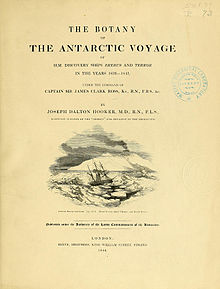 Title page with an etching of Victoria Barrier with Mount Erebus and Mount Terror; one of the expedition's ships is shown temporarily trapped in sea ice. | |
| Author | Joseph Dalton Hooker |
|---|---|
| Illustrator | Walter Hood Fitch |
| Language | English |
| Series | Monthly parts |
| Subject | Botany |
| Publisher | Reeve Brothers |
Publication date | 1844–1859 |
| Publication place | United Kingdom |
| Text | Flora Antarctica at Wikisource |
The Flora Antarctica, or formally and correctly The Botany of the Antarctic Voyage of H.M. Discovery Ships Erebus and Terror in the years 1839–1843, under the Command of Captain Sir James Clark Ross, is a description of the many plants discovered on the Ross expedition, which visited islands off the coast of the Antarctic continent, with a summary of the expedition itself, written by the British botanist Joseph Dalton Hooker and published in parts between 1844 and 1859 by Reeve Brothers in London. Hooker sailed on HMS Erebus as assistant surgeon.[1]
The botanical findings of the Ross expedition were published in four parts, the last two in two volumes each, making six volumes in all:
- Part I Botany of Lord Auckland's Group and Campbell's Island (1844–1845)
- Part II Botany of Fuegia, the Falklands, Kerguelen's Land, Etc. (1845–1847)
- Part III Flora Novae-Zelandiae (1851–1853) (2 volumes)
- Part IV Flora Tasmaniae (1853–1859) (2 volumes)
All were "splendidly" illustrated by Walter Hood Fitch, who prepared thousands of detailed botanical figures on 530 colour plates. The greater part of the plant specimens collected during this expedition are now part of London's Kew Herbarium.[2]
The Flora of Tasmania contains an introductory essay on biogeography written from a Darwinian point of view, making the book the first case study for the theory of evolution by natural selection. This has been seen as the foundation of evolutionary biogeography. Hooker gave Darwin a copy of the work, which proposed that plant groups on different landmasses had common ancestors, spreading via long-vanished land bridges. Darwin doubted the explanation but agreed that geographical distribution would be vital to understanding the origin of species. In the 21st century the book is still treated as a major reference work.